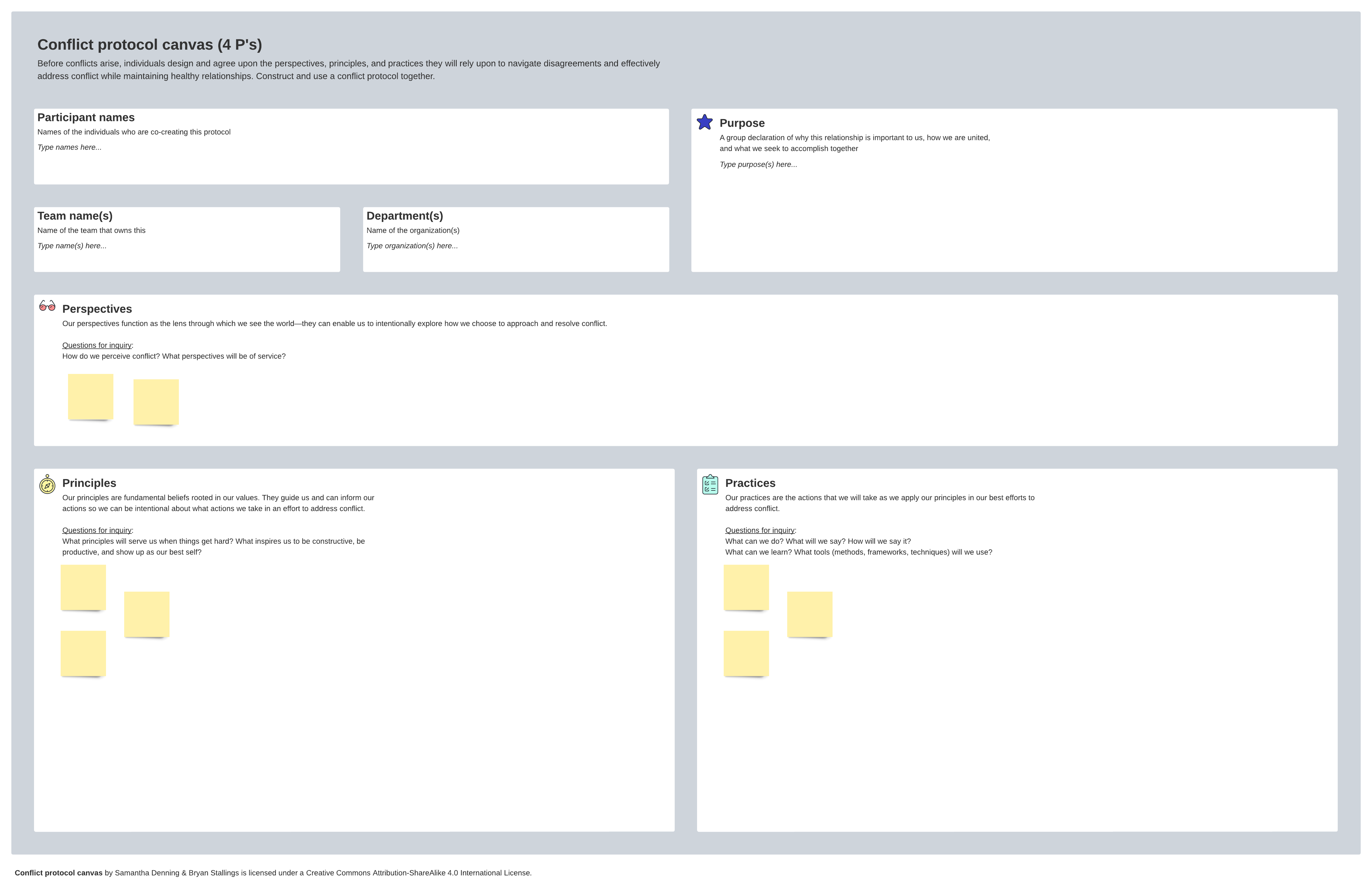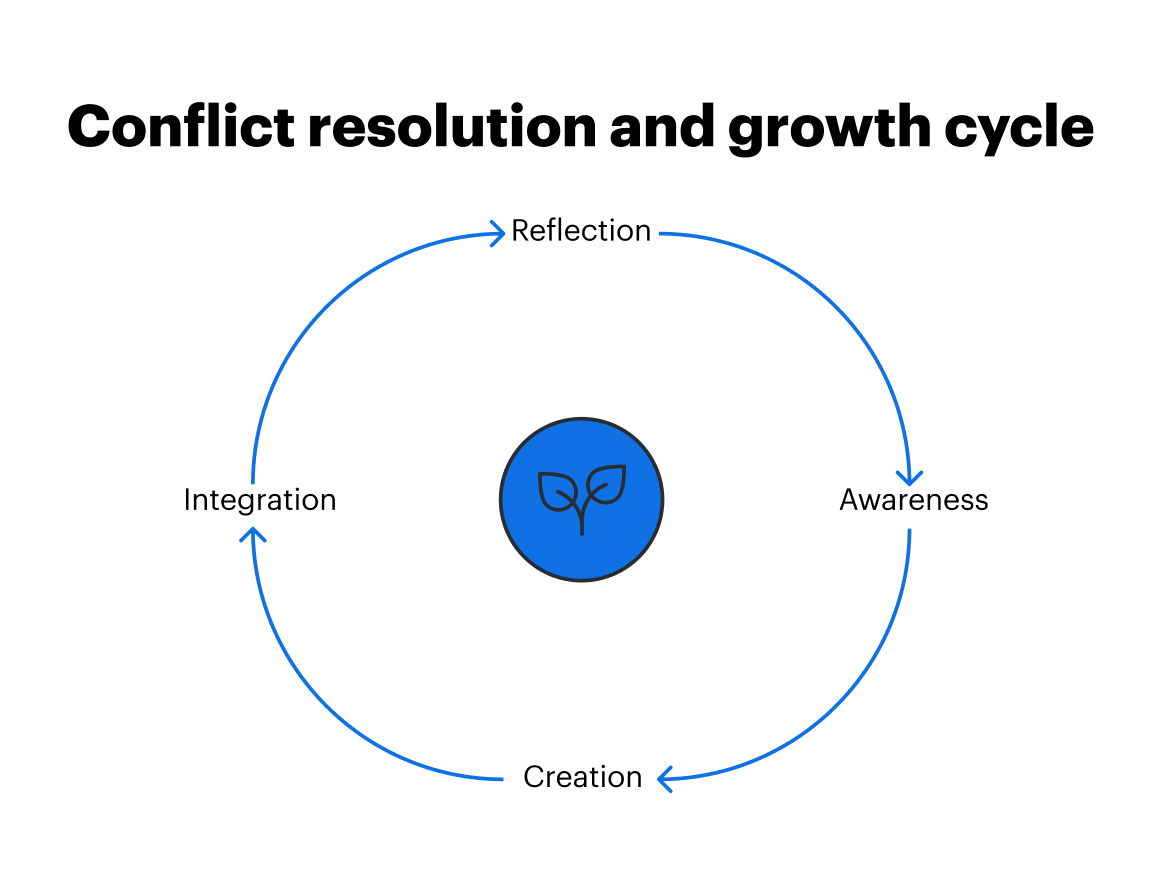
How leaders can use conflict as a tool for growth and team performance
Reading time: about 11 min
Conflict can be uncomfortable, troubling, and anxiety-inducing—but it’s inevitable. Whether arising from stress, personality differences, or miscommunication, conflict will manifest in newly complex ways as organizations look toward a future of hybrid work.
The good news is that conflict, when managed properly, can be an incredibly important ingredient to building high-performing teams. In fact, a McKinsey survey of 5,000 executives showed that a key environmental factor needed for high-performing teams to flourish was “high-quality interaction, characterized by trust, open communication, and a willingness to embrace conflict.”
To find out how leaders can embrace conflict as a tool for growth, we talked to Samantha Denning, an executive coach and expert in mediation and conflict resolution.
Denning, a leader in the Scrum and Agile communities and co-founder of coaching agency Unalome Agency, shared the importance of intentional conflict resolution strategies, with practical tips for leaders and teams to apply before, during, and after conflict.
The benefits of conflict resolution in the workplace
Leaders looking to improve collaboration, employee productivity, and innovation across their team should keep an an open mind towards conflict. With the right conflict resolution strategies in place, conflict can benefit organizations by:
- Increasing psychological safety. When organizations foster a culture that accepts and embraces conflict as a part of learning, teams will feel more secure in sharing their ideas. “With the right perspective and resources, conflict can be thought of as an opportunity to learn, grow, and improve workplace dynamics,” said Denning.
- Turbocharging innovation and productivity. Teamwork is a necessary component of innovation, which relies so heavily on idea-sharing and continuous learning. Conflict helps teams improve how they work together, so team members feel comfortable experimenting, taking risks, and sharing their learnings with their team.
- Helping the business deliver value. When workplace culture improves, business outcomes will also improve. A report from McKinsey suggests that “companies with strong cultures achieve up to three-times higher total returns to shareholders than companies without them.” Embracing conflict is a key part of building a strong, resilient culture. Organizations with conflict resolution strategies use conflict as an opportunity for learning and innovation, which in turn leads to increased employee retention, customer satisfaction, and financial growth.
For conflict to truly be a tool of growth, though, leaders need to design well-documented conflict resolution strategies and make this information widely available to every team member.
Conflict resolution by design, not default
Instead of looking for ways to prevent conflict, Denning suggests that leaders can look for ways to empower their workforce to intentionally respond to conflict.
Without established conflict resolution strategies, most people will default to reactive tendencies when conflict arises. This rarely settles disputes effectively. That’s why it’s important for leaders and teams to intentionally identify and agree on how they’ll think, act, and behave in the face of conflict.
“Designing conflict resolution strategies helps teams align on what capabilities, frameworks, and support systems are available to them, “ said Denning. “This empowers people and gives them the ability to repair relationships and meet their coworkers in a better place.”
Proactively designing conflict resolution strategies can be approached in the same way as building team working agreements, or a set of guidelines that teams collaboratively create and agree on about how they’ll work together. Organizations practicing Agile are likely familiar with working agreements, which typically include guidelines around working hours, meeting etiquette, and shared values. Conflict resolution should be approached in the same way—designed intentionally, iteratively, and collaboratively.
Conflict resolution strategies before conflict arises
Your best chance of resolving team conflicts successfully is by having a plan in place before the conflict ever begins. This stage is all about creating clarity and predictability with a plan that is easy to understand, so that when conflict does inevitably arise, teams are prepared to respond instead of defaulting to reactive behaviors.
Here’s how to get started:
Set an intention for how to approach the conflict
Before you identify what you want to do when conflict arises, decide how you want to be. “This is a proactive and slightly preventative strategy because you're essentially making an agreement of how you want to show up, with certain intentions that should guide you to better respond in this situation,” said Denning.
When defining how you want to be during the conflict, think of the emotional reaction the words you use may elicit. Take, for example:
- Responsive vs. reactive
- Curious vs. judgmental
- Open vs. closed
A team that agrees to be open and curious during conflict will act very differently than a team that’s closed and judgemental during conflict.
Create a conflict protocol collaboratively with your team
Once you’ve established your team’s intentions for approaching conflict, it’s important to provide them with the resources and tools to navigate disagreements. The best way to do this is to work collaboratively with your team to create a conflict protocol, which is a team agreement on how to communicate and act during conflict.
You can create a conflict protocol in-person or during a virtual meeting using an online template if your team is remote or hybrid. Either way, you’ll want your protocol in writing so you have a record of your discussion and a blueprint that anyone on your team can access and use. Based on her experience mediating conflict, Denning has identified four elements that are essential in a conflict protocol. Her framework, the 4Ps, addresses:
- Purpose: Collectively decide why your team relationship is important, what unifies you, and what your goals or mission are as a group.
For example, a product development team building something new may establish a purpose such as: “We are innovating something entirely new and we each have a diverse perspective. We want a healthy approach to conflict so that we resolve it effectively and everyone is comfortable sharing ideas.”
- Perspective: Explore how your team views conflict and what perspectives will inspire how you approach and resolve conflict. For instance, a team may agree to “assume positive intent” and “be curious” when approaching conflict.
- Principles: Define what fundamental beliefs or values your team holds. These will inform your team’s actions in the midst of conflict so you reach more productive outcomes. Examples of guiding principles could be kindness, empathy, or trust.
- Practices: Determine concrete actions your team can take based on the principles you established. List what you’ll say or do to address conflict. An example here would be to “ask powerful questions.”

The most important thing to keep in mind when filling out the conflict protocol is that all team members need to feel engaged, aligned, and in agreement throughout the creation. When team members feel bought-in to the process, they’re more likely to take ownership of their actions during conflict.
Denning explained that the process of creating a conflict protocol also provides an opportunity in itself to grow and bond as team.
“It gives an opportunity for different people to talk about what's important to them and to really learn about each other as a group—leaders should pay close attention to that.”
Have a backup plan
Despite all the work you put into building a conflict protocol, it might not be enough to resolve every conflict, and that’s okay. Knowing this, you can set the expectation with your team for how to respond in cases like this. “If the conflict escalates to a different level of interruption, you can plan to meet them with a different level of resources,” said Denning.
Denning recommends thinking of these as “what-if clauses.” For example, you may ask yourself: What if this doesn’t work? What are the clear next steps we can take?
You don’t need to have all the answers—but you do need to make it clear what your team can do, who they can go to, and what resources are available should situations require escalation.
Strategies in the midst of conflict
The right intentions and a conflict protocol established ahead of time will set a solid foundation for conflict resolution—but when emotions flare up and stress increases, things don’t always go as planned. These tips will help you and your team stay grounded in the heat of the moment:
Understand the root cause of the conflict
Conflict is often driven by experiences unrelated to the situation at hand. If stress is high in other aspects of someone’s personal life, that stress often manifests itself in their professional life as well. Encourage your team to approach arguments or disagreements with empathy, and keep in mind that there may be more to the story than you realize.
“We may think someone just doesn't like us or is really hot-headed, but then come to find out they’re going through a divorce, or just found out a loved one is sick, “ said Denning. ”Whatever the cause, it’s important to be aware of the human experience that everyone is having.”
Ask yourself, “Is this the best time, place, and environment for this conversation?”
Not all conflict has to be addressed immediately. Take into consideration other factors such as timing and location before starting (or continuing) a conversation. Denning recommends a simple equation to help weigh whether or not an immediate conversation is necessary: “In service of what, at the cost of what.” Consider if getting your point across is so important that it could damage the relationship, or potentially overwhelm or embarrass someone.
When you and your team are aware of these factors, you’ll be able to intentionally and thoughtfully respond, instead of reacting in a potentially regretful way.
If it is the right time and place to try to resolve the conflict, use tools like the conflict protocol with invitation, not demand. This ensures both parties are aligned on when and how to go about resolving the conflict.
Strategies after the conflict
The greatest growth often comes in the steps that happen after the conflict. This is a chance to purposefully reflect, learn, and improve as a team. Here’s a few post-conflict strategies you can try to maximize your team’s growth:
Do a retrospective on the conflict
Conflict can be a great opportunity to better understand yourself and your teammates, and improve team dynamics. Much like a retrospective you’d do after a large project, take some time to contemplate what happened in the conflict and what could be done to improve conflict resolution in the future. Denning recommends thinking of this as a continuous cycle, with these key components:
- Reflection. Reflect on what strategies were helpful in resolving conflict, what didn’t work, and what you could try when conflict arises in the future.
- Awareness. As you reflect, you’ll become aware of your own experience with the conflict, as well as others’ experiences and how these can differ.
- Creation. What actions are you inspired to try in the future? Think of what new behaviors or intentions you’d like to create.
- Integration. Decide how you’ll go about incorporating your learnings into your conflict resolution strategies.

Revisit and revise your conflict protocol as needed
As your team reflects on their experiences with conflict and learns more about each other, it’s important to regularly update your conflict protocols.
“You can reflect on how these tools have contributed to a better experience, where they have been helpful, where they haven't been helpful, and what you are inspired to create or change as a result,” said Denning. “Look at it as a living document.”
By thinking of your conflict protocol as a living document, you’ll be better able to create clarity and alignment around conflict resolution for all team members. If you use a virtual, visual collaboration platform to create and host your team’s conflict protocol, it’s easy to share with new team members, update as needed, and ensure everyone has the most recent version.
Conflict resolution considerations in a hybrid world
Hybrid work undoubtedly creates unique challenges that organizations must consider. Teams may struggle to build relationships naturally, remote staff may feel excluded, and miscommunications are more likely.
This adds a layer of complexity to conflict and conflict resolution. However, each individual’s experience with conflict in a hybrid world will vary.
“I think hybrid work is an accelerant in both ways,” said Denning. “I think hybrid heightens conflict in some ways, and decreases it in other ways.”
Without regular face-to-face interaction, some employees may be more dismissive of disagreements, while others use the impersonal nature of being remote to say things they might not say in person. This makes it even more important for team members to reflect on their own beliefs around hybrid work individually—and for you, as a leader, to create a space for this reflection, share your own experiences, and encourage individuals to share theirs. Denning offered this suggestion:
“What you can do is create a predictable place of respectful sharing and development, which includes a system for communicating, connecting, and supporting each other.”
Be patient as you and your team navigate complex working environments. Digital collaboration tools, combined with intentional conflict resolution strategies, provide a great starting point to improve team dynamics and performance. Embrace the process, lead with intention and inquiry, and as Denning says: “Be kind and stay curious.”

About Lucid
Lucid Software is a pioneer and leader in visual collaboration dedicated to helping teams build the future. With its products—Lucidchart, Lucidspark, and Lucidscale—teams are supported from ideation to execution and are empowered to align around a shared vision, clarify complexity, and collaborate visually, no matter where they are. Lucid is proud to serve top businesses around the world, including customers such as Google, GE, and NBC Universal, and 99% of the Fortune 500. Lucid partners with industry leaders, including Google, Atlassian, and Microsoft. Since its founding, Lucid has received numerous awards for its products, business, and workplace culture. For more information, visit lucid.co.
Related articles
Why is emotional intelligence important in leadership? Understanding the 4 quadrants of emotional intelligence
Learn emotional intelligence strategies for leadership and self-management of your own. Delve into the 4 quadrants of emotional intelligence (EQ).
3 ways leaders can use visuals as a catalyst for change
Agile leadership expert Pete Behrens shares insights on how leaders can use visuals to effectively lead their organizations through change.
3 Agile change management tips: Leading through transformation
In this blog post, we share three change management tips that leaders can champion for successful agile transformation.
Traditional vs. agile leadership, explained
In this blog post we will explain traditional leadership vs. agile leadership and share some tips for becoming a more agile leader.
